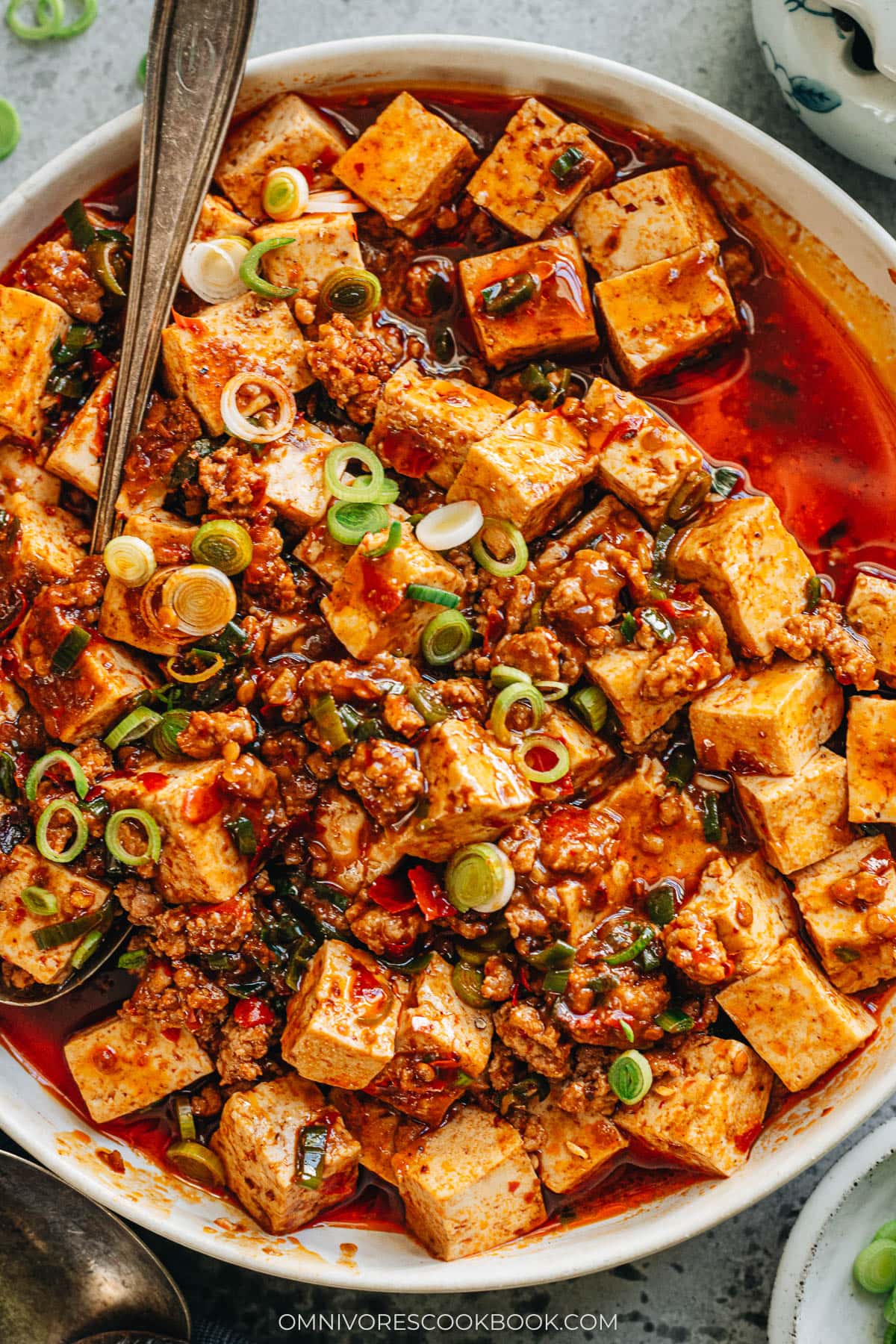
Mapo tofu (麻婆豆腐, ma po dou fu) is one of the most popular dishes from Sichuan cuisine. The tofu pieces are braised in a rich, spicy, savory sauce, along with fresh garlic and scallions. A small amount of ground pork enhances the flavor. The dish is so appetizing, and it goes perfectly with steamed rice.
Cooking mapo tofu is relatively easy, but you need a few special ingredients to get the authentic flavor. I’m sharing my favorite mapo tofu recipe below. It creates the very authentic taste that you’d get at a restaurant in China. However, you can easily tweak the dish according to your preferences.
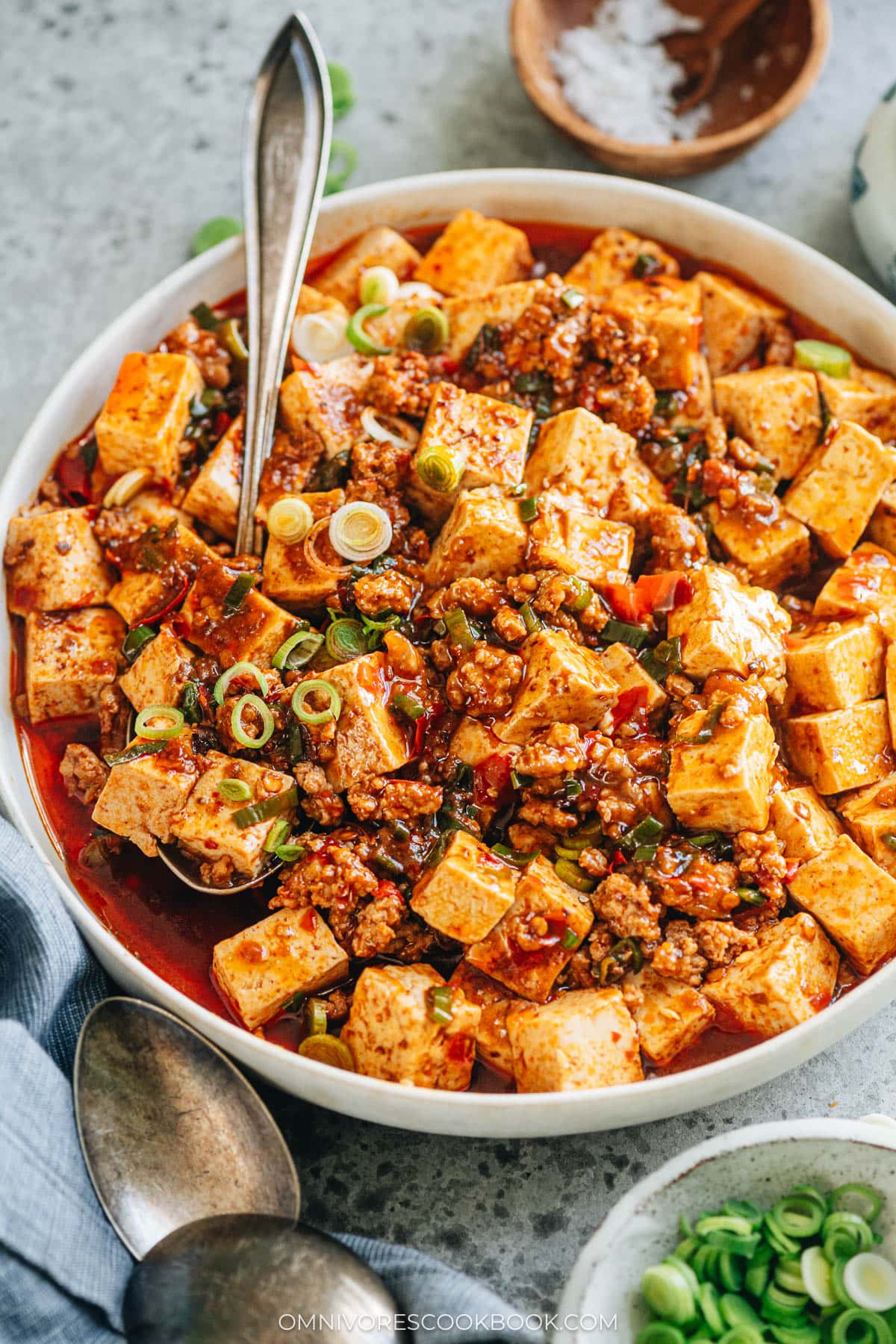
Key ingredients for Mapo Tofu
Doubanjiang
Doubanjiang (豆瓣酱), also known as spicy fermented bean paste, chili bean paste, chili bean sauce, or broad bean sauce, is the most crucial ingredient in mapo tofu. It has a strong, fermented, savory, salty, and spicy taste. Try to find “Pixian Broad Bean Paste” at your Asian market.Pixian is a small county in the Sichuan province that produces the best chili bean paste. If you’re using this brand, you’re already halfway there. You can also purchase this brand on Amazon here.
NOTE: The salt and spice level can vary greatly depending on the Doubanjiang brand. This dish is designed to be served with rice, so it’s on the salty side. To make your dish less salty and spicy, reduce the amount of Doubanjiang to 2 tablespoons.
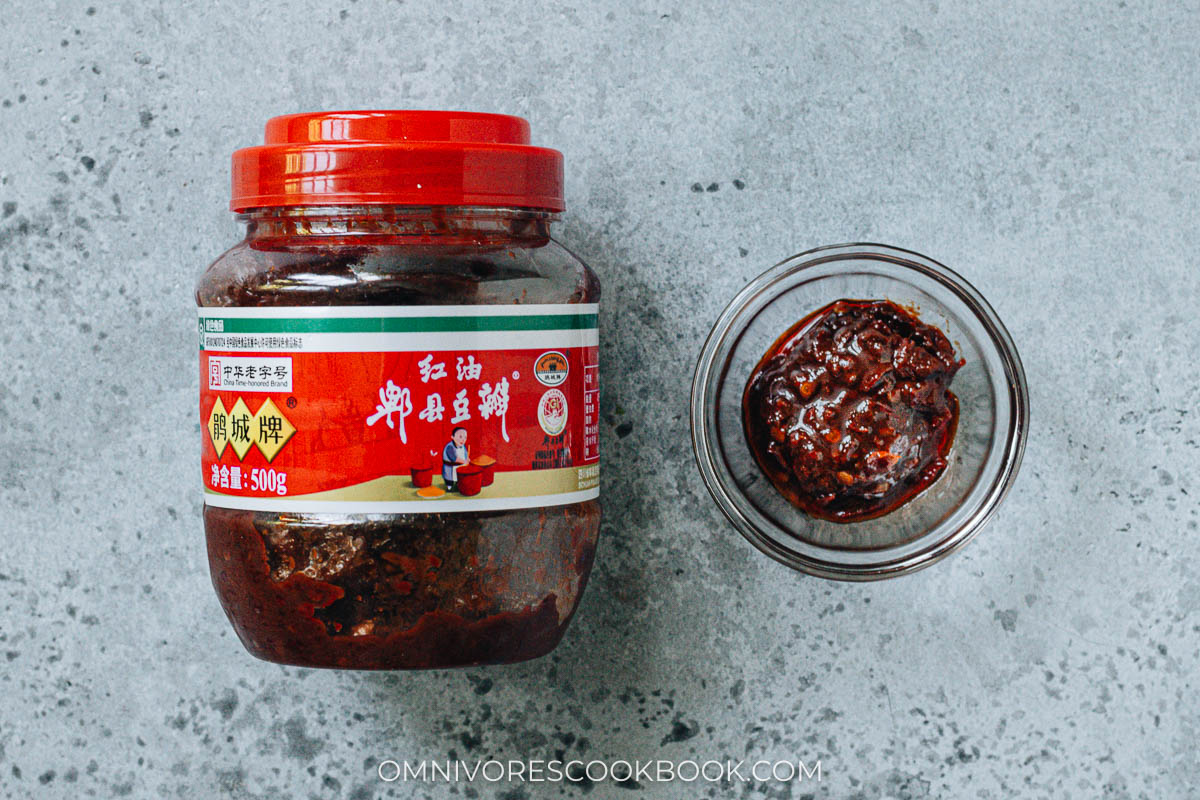
Sichuan peppercorns
Sichuan peppercorn (花椒, hua jiao) is another main ingredient in any Sichuan dish. It has a citrusy taste with a numbing tingling sensation when you chew on it. It’s a crucial and irreplaceable flavor-enhancing ingredient.. You can purchase Sichuan peppercorns at Asian grocery stores, but I highly recommend these premium fresh ones from The Mala Market.
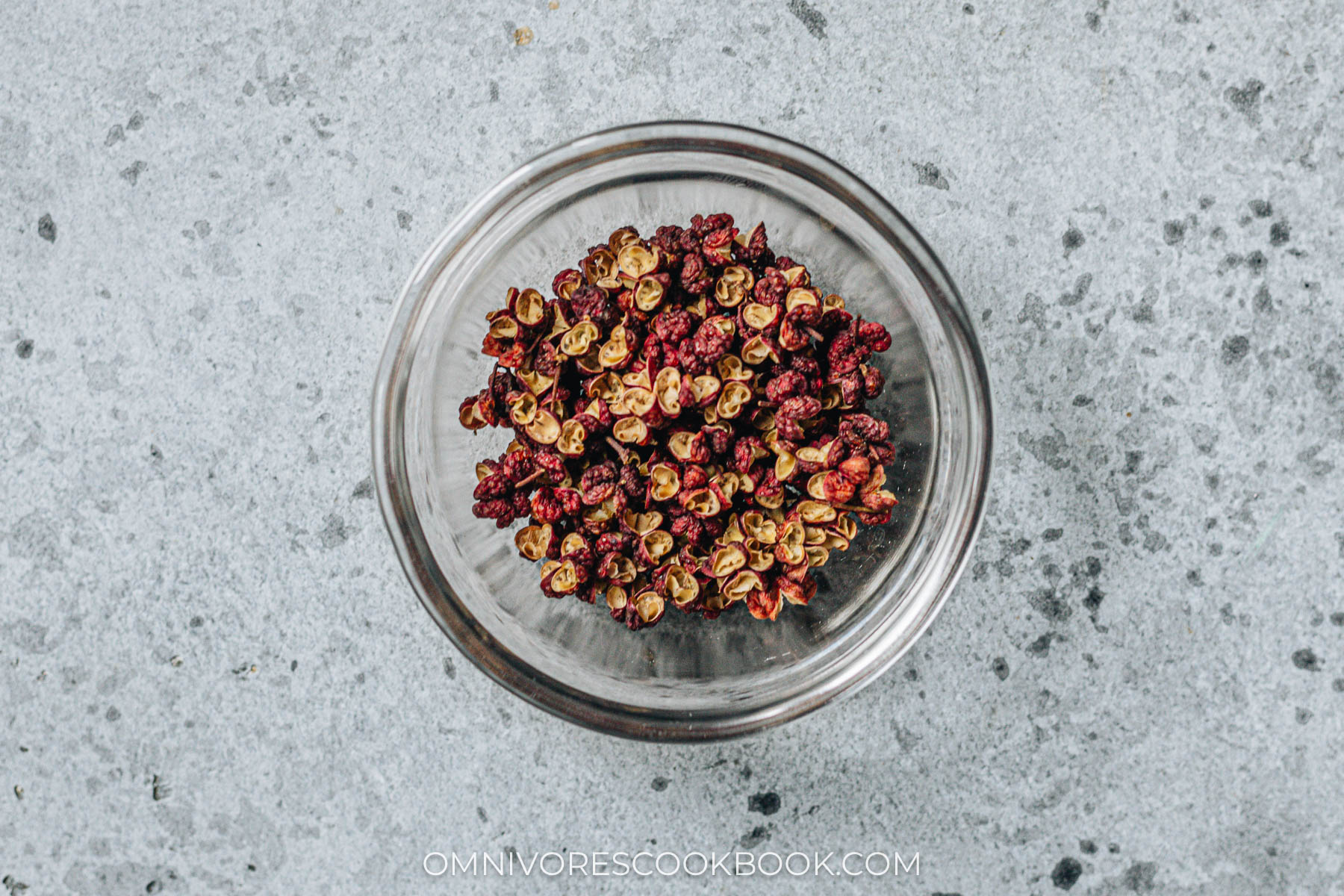
Sichuan peppercorn cooking tips
The most common way to cook Sichuan peppercorns is to fry them in hot oil. Doing so infuses the flavor and makes the dish milder. You can also grind the peppercorns and use them to garnish your dish later.
Alternatively, you can use ground-up fresh Sichuan pepper. I recently got a Sichuan peppercorn grinder from The Mala Market. I love that it’s fast and easy to use. Grind a small amount and add it when cooking or at the end to add flavor. If you have this product on hand, add 1/4 teaspoon ground Sichuan pepper when you add the ground pork.
When you use super fresh Sichuan pepper, the flavor is pungent. You may only need about half of the amount indicated in this recipe. The longer you store the peppercorns, the less fragrance they will have, and the more you need to use.
Homemade chili oil
The other essential ingredient is homemade chili oil (辣椒油). Freshly cooked chili oil tastes much better than store-bought and is free of additives. It only takes a few minutes to cook, and it’s really easy.
If you want to purchase chili oil, make sure to find a high quality one. And it should contains chili flakes and the oil, such as this one.
What to do with leftover chili oil?
You will usually cook more chili oil than you’ll use in one meal. You can store the extra oil in an airtight container in the fridge for 6 months to a year. Use it in various dishes, including Sichuan spicy wonton in red oil and Fu Qi Fei Pian (sliced beef in hot sauce). You can also add it to a dipping sauce for potstickers, to wonton soup to enhance the flavor, or even put it on oatmeal!
It might look like you need so many specialty ingredients for this one dish. But trust me, if you love Sichuan food, you’ll use them repeatedly.
How to cook mapo tofu
Fry the Sichuan peppercorns in the oil to infuse the aroma
- Fry the Sichuan peppercorns in the oil to infuse the aroma.
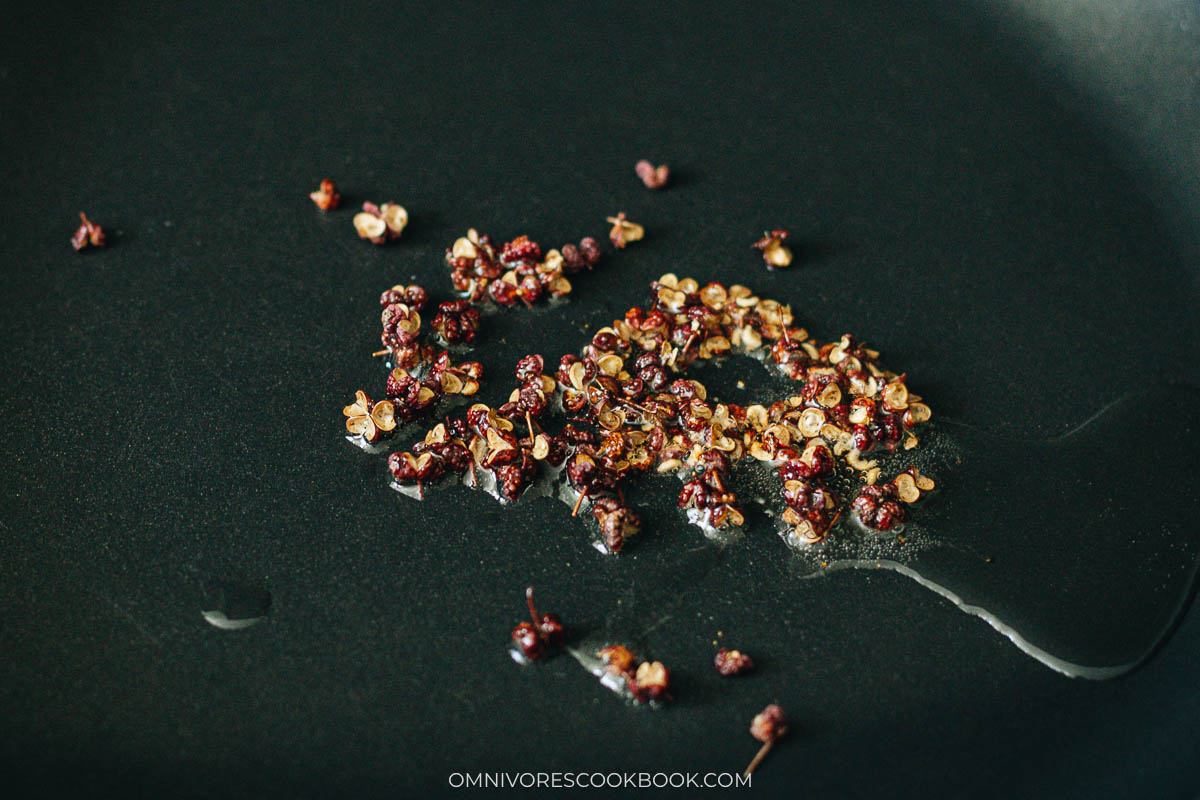
- Cook the ground pork with doubanjiang.
- Once the pork is cooked, add the green onions and stir a few times.
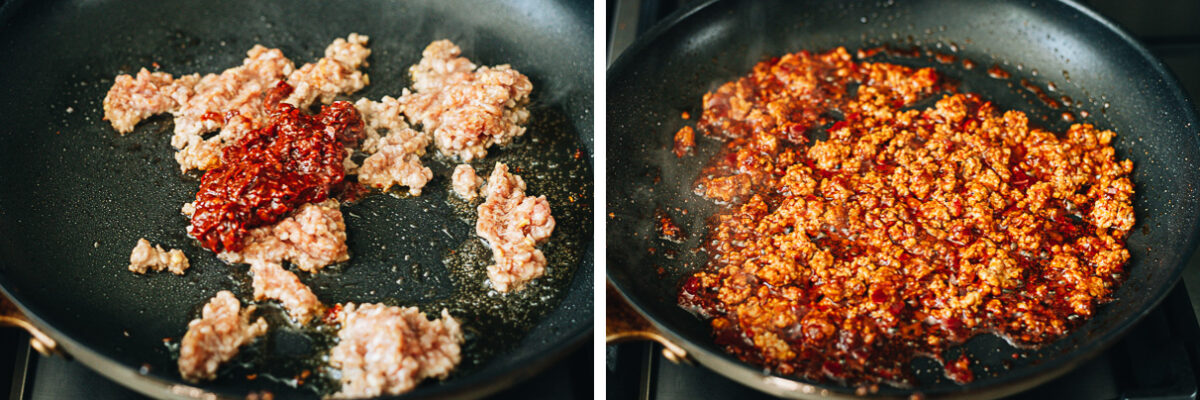
- Add the broth, tofu cubes, and braise with the cover on.
- Drizzle in the cornstarch mixture to thicken the sauce. Sprinkle with scallion greens for garnish.
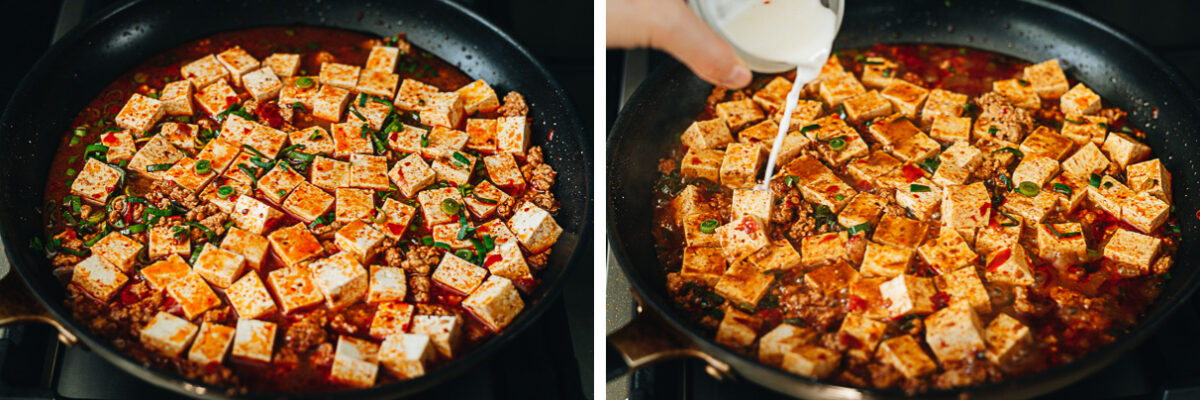
That’s it! I think this is one of the easiest Sichuan recipes, and the result is super rewarding 🙂
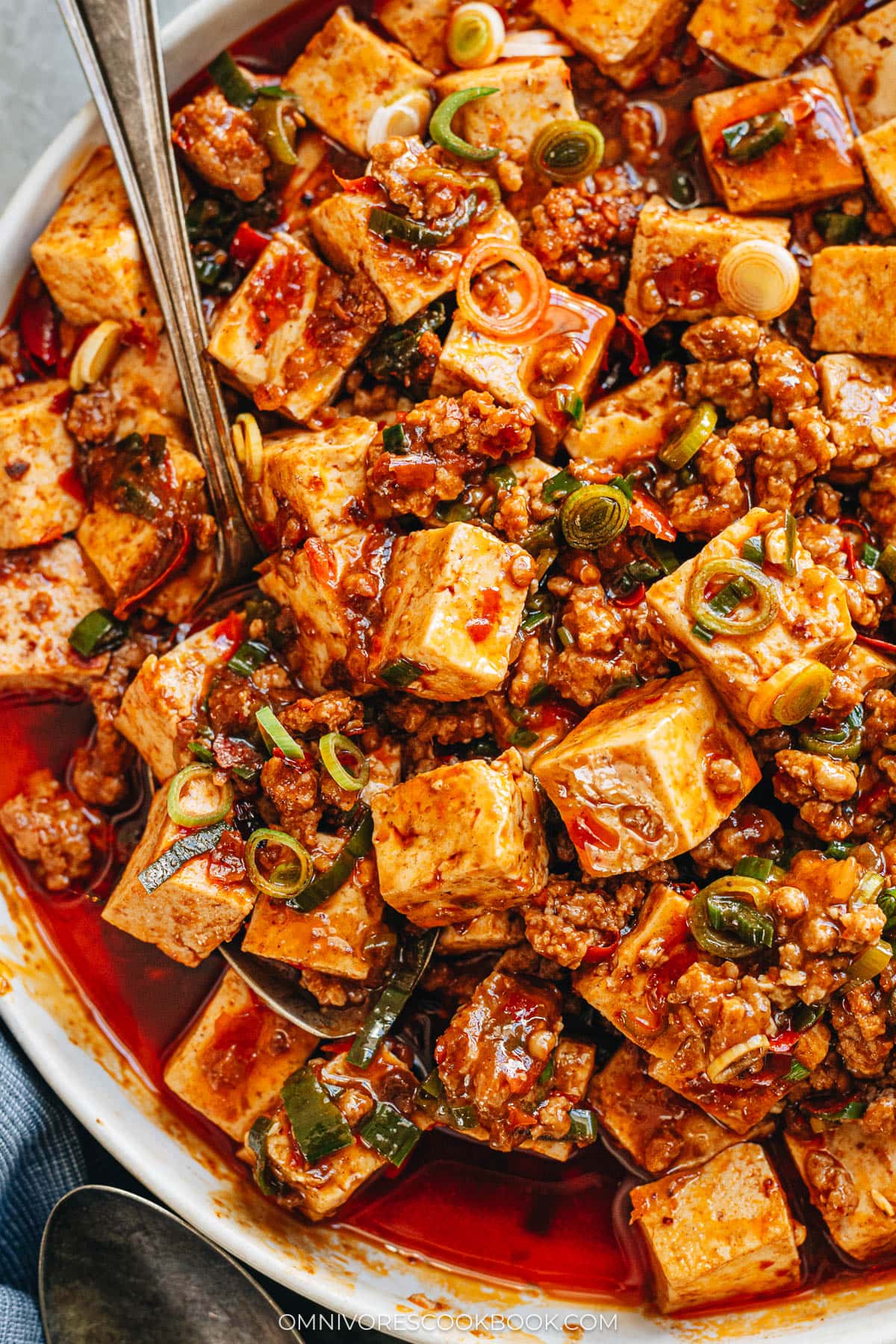
How to serve mapo tofu
I love cooking mapo tofu for a quick lunch or dinner and serving it over steamed rice. Sometimes I double the meat and sauce, so it will be enough to serve two people as a one-dish meal.
I also like to add a handful of greens (spinach, garlic chives, or other tender greens such as chopped up baby bok choy) at the end of braising before adding the cornstarch, to create a more nutritious and balanced meal. Sometimes I also replace the ground pork (used in the authentic version) with ground beef, or ground chicken, depending on what I have in the fridge.
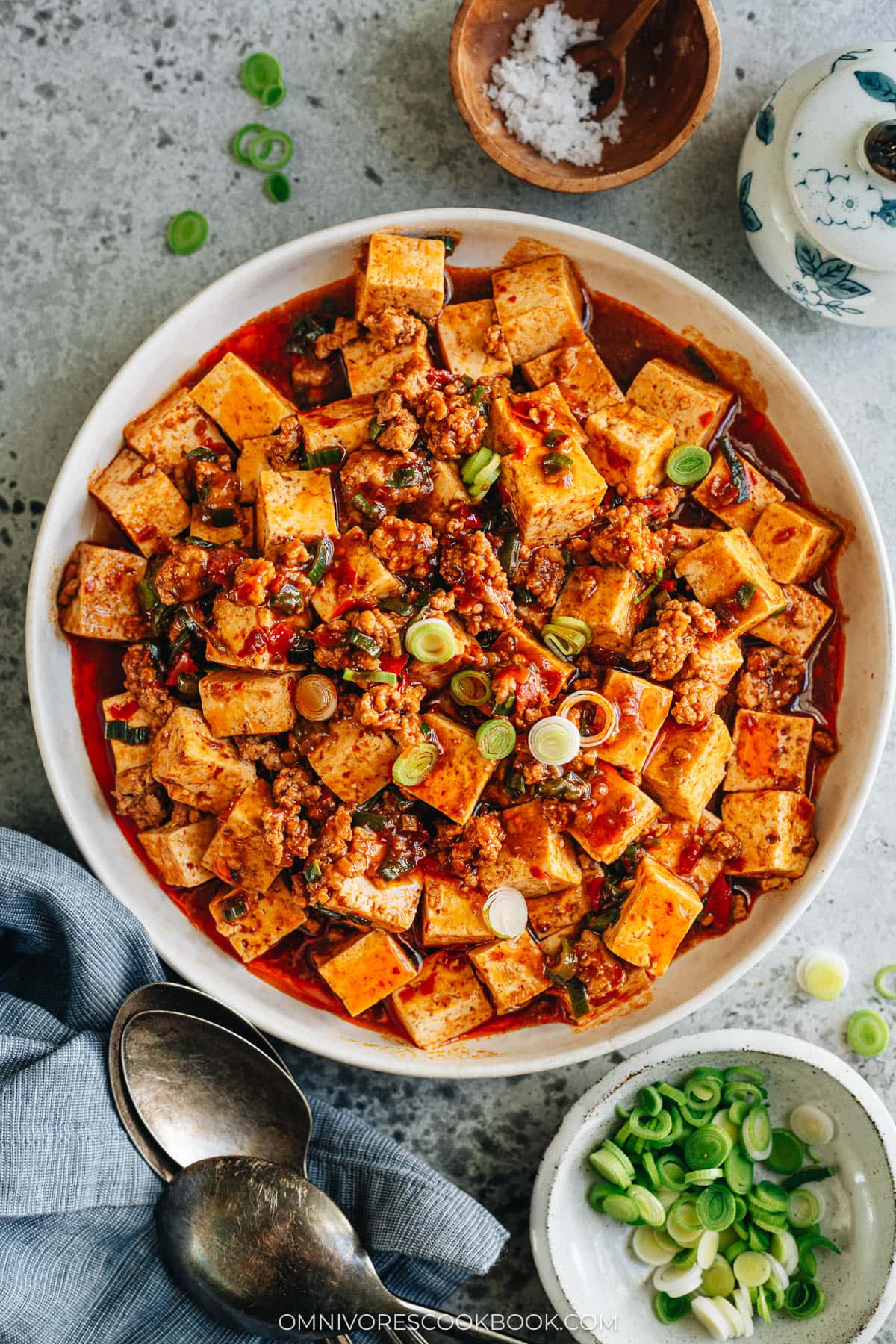
Frequently asked questions
What type of tofu should I use for mapo tofu?
There is no correct answer; you should choose what works best for you. Some Chinese restaurants, including many in China, prefer soft or silken tofu for a melt-in-your-mouth texture. This method requires some experience handling tofu, so you won’t break apart the delicate silken tofu while cutting and cooking.
This dish can also use extra firm, firm, or medium tofu, which is much easier to handle. Plus, once you braise the tofu in the rich, spicy sauce, it absorbs a lot of flavor and tastes great.
Do I need a wok to cook mapo tofu?
Not at all! I found it’s easiest to cook mapo tofu in a nonstick pan. The tofu will sit flat in the broth and absorb all the flavor. Plus, it won’t stick to the pan or fall apart when you stir it.
How do you make mapo tofu vegetarian or vegan?
I have a vegan mapo tofu recipe here that tastes super flavorful!
Chinese Cooking Made Easy
Are you new to this website? This free email series is a great place to start. I’ll walk you through a few of my most popular recipes and show you how and why they work. You’ll quickly start to cook better Chinese food in your own kitchen.
Watch video
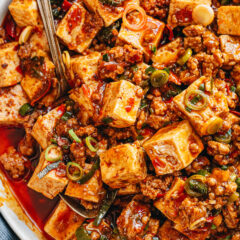
Authentic Mapo Tofu (麻婆豆腐)
Ingredients
Marinating
- 4 oz ground pork (or chicken, or turkey) (*Footnote 1)
- 2 teaspoons Shaoxing wine (or dry sherry)
- 1 teaspoon light soy sauce
- 1/2 teaspoon minced ginger
For braising
- 1 teaspoon cornstarch (optional) (*Footnote 2)
- 2 teaspoons Sichuan peppercorns , increase to 3 teaspoons if you like your dish extra numbing, or reduce to 1 teaspoon if your Sichuan peppercorns are extra fresh
- 1 tablespoon peanut oil (or vegetable oil)
- 3 tablespoons Doubanjiang , reduce to 2 tablespoons for a less saltier and less spicy taste
- 2 green onion , chopped
- 1 block firm or medium firm tofu , cut into 1.5cm (1/2 inch) squares
- 1 cup chicken stock (or water)
- 2 teaspoons homemade chili oil (*Footnote 3)
- 1/4 teaspoon five-spice powder
- 1 teaspoon sugar (or to taste)
Instructions
- Combine ground meat, cooking wine, soy sauce, and ginger in a small bowl. Mix well.
- Combine cornstarch with 1 tablespoon of water in a small bowl. Mix well and set aside.
- Heat the oil and Sichuan peppercorns in a large nonstick skillet over medium-high heat. When the Sichuan peppercorns turn dark brown and crispy, scoop them out with a spatula and transfer into a bowl layered with paper towels to soak extra oil. Save to use for garnishing the dish (Optional).
- Add the ground meat and Doubanjiang. Cook over medium heat and chop the ground meat into small bits with a spatula, until pork is evenly coated with Doubanjiang and fully cooked through. Add green onion and stir fry for another minute.
- Spread tofu evenly on top of ground pork (*Footnote 4). Add chili oil, five-spice powder, and sugar. Pour in the broth and cook until brought to a simmer. Simmer, covered, over medium-low heat for 8 to 10 minutes, or until the sauce has reduced to half the original amount. Taste the tofu with some broth (be careful, it will be very hot!). Adjust seasoning by adding salt if needed. If the dish is too spicy, add another teaspoon of sugar to balance it out. Gently mix well with spatula.
- (Optional) Meanwhile, grind the fried Sichuan peppercorns (you used when heating up the oil) in a coffee grinder or using mortar and pestle.
- Mix cornstarch water again until fully dissolved and swirl it into the skillet. Gently stir a few times with a spatula, until sauce thickens. Turn off heat and transfer everything to a bowl.
- Garnish with extra green onion and a small pinch of the ground Sichuan peppercorns, if using (*Footnote 5), if using. Serve hot over steamed rice or by itself as main.
Notes
- You can skip the meat and make this dish vegetarian. In this case, I highly recommend replacing the meat with mushrooms (such as rehydrated dried shiitake mushrooms) to enhance flavor.
- If you like the tofu with more broth, you can braise the tofu for a shorter time and use the cornstarch slurry to thicken the broth. Alternatively, you can uncover and braise until most of the liquid evaporates. The tofu will absorb more flavor this way.
- You can also pour on more chili oil for the restaurant look!
- Do not stir the tofu immediately after adding it into the skillet, in order to keep the pieces from breaking apart. The tofu will get firmer after braising and you can stir it once it’s cooked.
- The Sichuan peppercorns add a numbing nutty aroma to the dish. The fried Sichuan peppercorns have a more rounded body so it works great for garnishing the dish or in a salad. You only need a small amount in this recipe to finish up the dish. Store the rest in an airtight container, no longer than a month.
Nutrition

Did you make this recipe?
I’d love to hear how it turned out for you! Please take a moment to leave a 5-star rating ⭐️ and share your thoughts in the comments further down the page. It really helps others discover the recipe too.

Ky
I’ve been looking for this recipe since I sadly broke up with my Chinese girlfriend. Cooking it brought back the memories of those wonderful days and trips to China. I also got to buy a new ingredient Doubanjiang. More recipes please.
Volkan
I hope you live a happy family with a chinese partner
Emma
This recipe is amazing! The dish was delicious, and a lovely amount of spicy. For any vegetarians out there, I highly recommend using Yves Ground Round instead of the meat – it’s a perfect substitute for this dish 🙂
Mister Jack
Very tasty and happy with outcome, when I prepared it I could smell the restaurants of China
Alyssa
Great recipe!! Good amount of spice and the flavors were amazing. Thanks for sharing!
Jackson
Scaled up the recipe x3, the saltiness made it inedible. Other people seem to have loved this dish so I was sad it turned out this way but it seems others have had the same issue when scaling up. Just a heads up.
Willie
This was fantastic, though I simmered a bit too long and didn’t end up with as much sauce as I would have liked. Watch it as it gets near the end! I used a mix of firm and medium tofu, and liked the firm better so will stick with that next time. I’ll also cut back slightly on the doubanjiang – maybe 2.5 tbsp rather than 3.
David J
I’ve made this twice now. Really good! Glad I live near an Asian grocer, for the the doubanjiang.
Cyndi Chu
Is this recipe intended for one or two packs of tofu?
Maggie
It’s designed for one block of tofu.
Sohbet
It is a wonderful recipe I tried this recipe at home in the evening and it was very delicious and it also reminded me of nusr-et
Pam
Just made this recipe for the first time. It was amazing!! Thank you!
Anantika
I made this twice (the same day) and it turned out so good! I’ve messed up mapo tofu so many times before, and it’s really so difficult to get the ingredients here in India. Thanks for this super simple and easy to follow recipe! It works wonders and tastes oh so 美味可口!
Pat
All the doubagjiang in the markets and online has wheat in it. Can it be had without wheat?
Maggie Zhu
So far I’ve only seen one Japanese brand that carries the Doubanjiang without wheat: https://amzn.to/3drXlel
It’s quite salty and not as flavorful and thick as the Chinese type. But you can use it if you need gluten-free product.
Aaditi
Quick, easy and DELICIOUS! I used jarred chili oil, chicken stock, and 2 tbsp of the brand of doubanjiang I have.
Rista
Hi! I live in NYC. I know that you suggest to make our own chili oil, but I was broken hearted twice because the taste of my chili oil were not that I expected. So, can you please suggest me the best chili oil brand that you have ever purchased/tasted? and where to get it? Thank you. I really appreacite it
Maggie
The Blank Slate chili oil is really good: https://amzn.to/3ggX5zz
Also love Mr Bing chili crisp: https://amzn.to/2JPQiRp (more dried chili and it’s great for seasoning food like top on nooles)
Nick
How many tbsp of Les Kum Kee doubanjiang would you recommend for the dish serving 4 people?
Maggie
You can follow the recipe and use 3 tablespoons.
Sharif Siddique
Hello there,
That’s a great article about authentic mapo tofu.
Keep your good job.
Sharif Siddique
Hi MAGGIE,
This is one of the most informative article for me. Thanks for your good job.
Susi V
Fantastic and easy recipe that is now the star of many weeknight dinners, along with rice and some simple stir fried greens. I have successfully made it with pork, chicken and most recently with diced impala fillet and Chinese mushrooms! I read the saltiness debate and my advice for someone making this the first time is to be a bit conservative when first adding the bean sauce and then tasting and adjusting it if necessary halfway through braising. Between the variation in bean sauce brands and people’s tolerance and preference for saltiness, it is really difficult to give an accurate suggestion that will work for everyone, especially for a strongly flavoured dish like this where one wants to use the maximum amount of bean sauce that is not going to overdo the saltiness.
Poolity
Hello MAGGIE,
Thanks to discuss about the authentic mapo tofu. Keep your good job.
NY
I wish I put in the third tablespoon! I read the reviews and was worried about the salt level but in the end it could have used more depth of flavor. I should have trusted you!
Maggie
Yeah the quantity of doubanjiang is a bit tricky sometimes depending on the brand you use. I use two types and I do use different tablespoons depending on the brand. Hope next time it will turn out better!